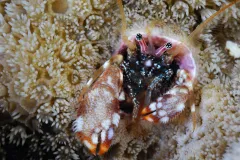The Perfect Underwater Photo

There is of course, no such thing as the perfect photograph, as there is no perfect song, movie, or painting. Photography by its very nature is subjective and what appeals to one viewer may not interest another. There are photographic elements however, that have been proven to make images better, especially things like exposure and composition. Photos that are over- or under-exposed are generally not pleasing to the eye, and composition tends to be more interesting when artistic styles such as the rule of thirds are followed (placing a key subject off center within the frame at the place where lines intersect, if the frame was divided by 3 lines running horizontally and vertically). Understanding how to make a technically good photograph is the foundation of photography, and from there photographers can explore their own vision.
Shooting underwater is a rather unique pursuit within the genre of wildlife photography, and there are gauntlets of challenges with which the shooter must contend. To explore beneath the sea is to travel to an alien realm where the explorer/photographer can only remain as long as their air supply lasts. Even in the warmest of water, divers will get cold eventually; so thermal considerations are also a factor. With our cameras sealed inside pressure-proof housings, we cannot change lenses or compact flash cards (or film, for those using that medium). And the ocean acts as a giant blue filter, scattering, reflecting, and refracting light so photographers must light their subjects with strobes if any color or detail is to be rendered in the final picture. Lighting one’s subject means getting close; typically within one or two meters unless the picture will be made with only ambient light. Getting close to wildlife photographically on land often requires hiding out in blinds or using telephoto lenses, but neither of these options is available to the undersea photographer. Still, after 35 years of exploring the world’s oceans with a camera, I never cease to be amazed that despite all the challenges, animals do allow you into their world and great photographs continually get made in the sea.
I have often described the world beneath the waves as a giant kaleidoscope; a place that is always changing with movement, colors, and light. While no single image can capture everything, in my own work I am most pleased when I make pictures that reveal something special about a specific animal or ecosystem, pictures that give viewers a sense of the mysterious or in effect bring them into the sea with me. In my book Ocean Soul I write that, “I believe my most important role remains as artistic interpreter of all that I see. I need to understand the science, but I want to capture the poetry.” A perfect photo for me is one in which I can combine animal behavior or stunning seascapes with graceful gestures and fluidity. This might be a school of fish foraging on a reef at dusk, a tiny crab emerging from its home inside coral, or a butterfly fish being cleaned by another fish in the water column.
To achieve these results I have to completely immerse myself within the place I am working (no pun intended). Often when I first begin working in a new location, all that I see is chaos, fish swimming around and so many things happening that I simply don’t understand. I have found that if I can zero in on specific behaviors of individual animals and begin making pictures of small things that I see, it helps me to understand the broader scene. Through this process I can begin to craft photographs that bring together multiple elements. And with each picture I make, I begin to piece together the grander puzzle of what is happening in the ocean.
So although there may be no single, perfect undersea photograph, there are images that are special; photos that through the skillful use of technique and vision reveal something about wildlife and the places they live in the sea.
Editor's Note: Want more? View The Perfect Underwater Photo and Swimming with Sharks, two image galleries by Brian Skerry on the Smithsonian Ocean Portal.

